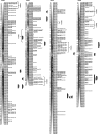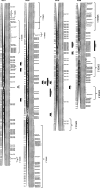A high density SLAF-SNP genetic map and QTL detection for fibre quality traits in Gossypium hirsutum
- PMID: 30522437
- PMCID: PMC6282304
- DOI: 10.1186/s12864-018-5294-5
A high density SLAF-SNP genetic map and QTL detection for fibre quality traits in Gossypium hirsutum
Abstract
Background: Upland Cotton (Gossypium hirsutum) is a very important cash crop known for its high quality natural fiber. Recent advances in sequencing technologies provide powerful tools with which to explore the cotton genome for single nucleotide polymorphism marker identification and high density genetic map construction toward more reliable quantitative trait locus mapping.
Results: In the present study, a RIL population was developed by crossing a Chinese high fiber quality cultivar (Yumian 1) and an American high fiber quality line (CA3084), with distinct genetic backgrounds. Specific locus amplified fragment sequencing (SLAF-seq) technology was used to discover SNPs, and a genetic map containing 6254 SNPs was constructed, covering 3141.72 cM with an average distance of 0.5 cM between markers. A total of 95 QTL were detected for fiber quality traits in three environments, explaining 5.5-24.6% of the phenotypic variance. Fifty-five QTL found in multiple environments were considered stable QTL. Nine of the stable QTL were found in all three environments. We identified 14 QTL clusters on 13 chromosomes, each containing one or more stable QTL.
Conclusion: A high-density genetic map of Gossypium hirsutum developed by using specific locus amplified fragment sequencing technology provides detailed mapping of fiber quality QTL, and identification of 'stable QTL' found in multiple environments. A marker-rich genetic map provides a foundation for fine mapping, candidate gene identification and marker-assisted selection of favorable alleles at stable QTL in breeding programs.
Keywords: Fiber quality traits; Genetic map; Quantitative trait loci mapping; Single nucleotide polymorphism marker; Specific locus amplified fragment sequencing (SLAF-seq); Upland cotton (Gossypium hirsutum L.).
Conflict of interest statement
Ethics approval and consent to participate
We have all relevant rights to the materials used in this study. All materials were grown in the field in accordance with local legislation.
Consent for publication
Not applicable.
Competing interests
The authors declare that they have no competing interests.
Publisher’s Note
Springer Nature remains neutral with regard to jurisdictional claims in published maps and institutional affiliations.
Figures








References
-
- Ashraf M, Akram NA, Mehboob Ur R, Foolad MR. Marker-assisted selection in plant breeding for salinity tolerance. Methods Mol Biol. 2012;913:305–333. - PubMed
-
- Hyten DL, Cannon SB, Song Q, Weeks N, Fickus EW, Shoemaker RC, Specht JE, Farmer AD, May GD, Cregan PB. High-throughput SNP discovery through deep resequencing of a reduced representation library to anchor and orient scaffolds in the soybean whole genome sequence. BMC Genomics. 2010;11(1):38. doi: 10.1186/1471-2164-11-38. - DOI - PMC - PubMed
MeSH terms
Substances
Grants and funding
LinkOut - more resources
Full Text Sources
Other Literature Sources

